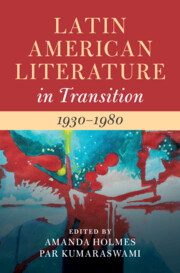Book contents
- Latin American Literature in Transition 1930–1980
- Latin American Literature in Transition
- Latin American Literature in Transition 1930–1980
- Copyright page
- Contents
- Contributors
- Introduction
- Part I War, Revolution, Dictatorship
- Part II Metropolis and Ruins
- Part III Solidarity
- Part IV Aesthetics and Innovation
- Index
Chapter 11 - Beyond the Nation Frame: Rethinking the Presence of Indigenous Literatures in the Spanish American Novel circa 1950
from Part III - Solidarity
Published online by Cambridge University Press: 24 January 2023
- Latin American Literature in Transition 1930–1980
- Latin American Literature in Transition
- Latin American Literature in Transition 1930–1980
- Copyright page
- Contents
- Contributors
- Introduction
- Part I War, Revolution, Dictatorship
- Part II Metropolis and Ruins
- Part III Solidarity
- Part IV Aesthetics and Innovation
- Index
Summary
Across the literary traditions of Spanish America, Indigenous peoples appear as resource materials for non-Indigenous authors and as emblems for national identity, rather than as literary creators themselves. Acclaimed examples from the mid-twentieth-century canon of what Angel Rama termed “transculturated narrative” are no exception: despite overt attempts to create works expressing solidarity with Indigenous peoples, these do not elude the colonial legacies, which have obliged Indigenous peoples to cede control of their words and the contexts that make these words meaningful. However, by working at the intersection of Latin American and Indigenous literary studies, this essay pursues those other contexts beyond the nation frame and returns to Miguel Angel Asturias’ Hombres de maíz and José María Arguedas’ Los ríos profundos. It charts Latin American literature and criticism across two historical transitions: the transition produced by indigenismo toward the horizon of a national identity discourse more centered on “the Indian”; and the transition produced by Indigenous movements away from that emblematic “Indian” and toward the horizon of Indigenous self-determination. To what extent can these Spanish-American novels, product of the first transition, be harnessed to that second transition to offer a window onto native ways of conceiving Latin American space and time?
Keywords
- Type
- Chapter
- Information
- Latin American Literature in Transition 1930–1980 , pp. 182 - 197Publisher: Cambridge University PressPrint publication year: 2022

